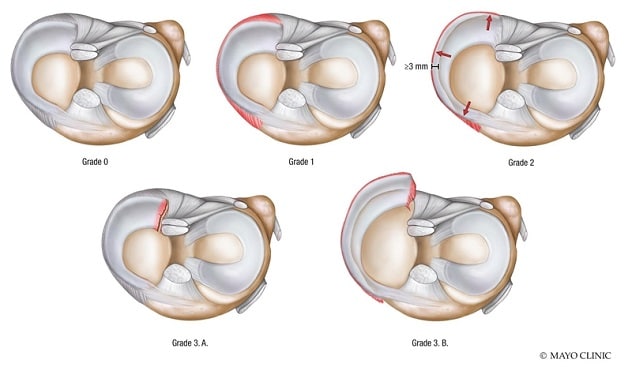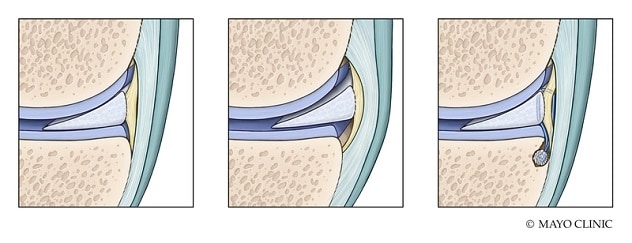Nov. 21, 2023
Out of seemingly nowhere, individuals can have acute knee symptoms despite participating in only low-impact activities. They feel as though something is free-floating in the affected knee. The feeling is almost like a watermelon seed sliding around with a pinching sensation, according to Aaron J. Krych, M.D., an orthopedic surgeon and sports medicine specialist at Mayo Clinic's campus in Minnesota.
Background on meniscus root tears
This scenario may indicate that a patient has experienced a meniscus root tear, a tear at the junction of the knee's meniscus and bone. This type of tear often occurs with twisting or rotational movements, or loaded knee flexion, such as lifting a weighty object. A meniscus root tear may occur in circumstances that appear benign, such as walking up a flight of stairs or stepping off a curb. It also can occur with a sports activity such as pivoting in pickleball or lifting a heavy kayak into the water. Athletes also incur meniscus root tears with an accompanying ACL tear in a more traumatic injury. However, most meniscus root tears are isolated and may affect people in any population at any point throughout life.
"Meniscus root tears were like a silent epidemic. Patients were presenting with pain, but we didn't recognize what was happening. Ten or 15 years ago or more, we couldn't explain the patient's symptoms, and often they were thought to have a low pain threshold, as the X-rays only showed mild changes."
Obesity may present a risk factor for a meniscus root tear. Higher BMI implies that the individual's body exerts more pressure on the knee. There may be additional misalignment as a contributing factor, akin to what can occur with a misaligned car tire, says Dr. Krych.
This injury can occur with older adults when a knee develops osteoarthritis. It also may affect children and adults of all ages when extrusion has occurred and the knee joint becomes vulnerable to high force, especially during knee flexion. Orthopedic surgeons performing total knee replacements (TKRs) have discovered that a high percentage of patients have root or posterior horn tears present. A study by Choi and colleagues published in Knee Surgery & Related Research in 2015 found these tears in up to 78% of patients at the time of TKR.
Dr. Krych describes a meniscus root tear as both painful and a cause of significant functional issues. Patients who experience this injury can walk, yet they experience increasing physical stress. Over time, increased knee pressure can produce stress fractures, significantly increasing patients' pain. Dr. Krych explains that patients who have experienced highly symptomatic meniscus root tears often have experienced significant bony stress as well.
"It's a devastating injury — you can get rapid cartilage loss," said Dr. Krych. "In a year's time, you can go from mild joint space narrowing to bone against bone arthritis."
Emerging focus on meniscus root tears
Focus on meniscus root tears has grown in recent years. Ten to 15 years ago or more, the orthopedic community overlooked these tears, as explained in a 2018 study by Dr. Krych and colleagues published in Orthopaedic Journal of Sports Medicine. Now, orthopedic surgeons specializing in knees recognize them more frequently, he says.
"Meniscus root tears were like a silent epidemic," says Dr. Krych. "Patients were presenting with pain, but we didn't recognize what was happening. Ten or 15 years ago or more, we couldn't explain these patients' symptoms. Often, they were thought to have a low pain threshold, as the X-rays only showed mild changes."
Dr. Krych indicates that the orthopedic community lacked sufficient research related to this injury, prompting him and his colleagues to investigate it in depth.
Clasificación de extrusión y desgarro de menisco, sistema de clasificación de ligamento meniscotibial y de raíz posterior del menisco medial

Clasificación de extrusión y desgarro de menisco, sistema de clasificación de ligamento meniscotibial y de raíz posterior del menisco medial
Clasificación de extrusión y desgarro de menisco, ligamento meniscotibial y sistema de clasificación de la raíz posterior del menisco medial. El ligamento meniscotibial falla en el estado de extrusión, lo que lleva a fuerzas concentradas en la raíz, que luego provocan el desgarro de la raíz.
His research team has found that meniscus root tear formation can brew in the background, escaping patients' notice. According to the team's findings, published in Orthopaedic Journal of Sports Medicine in 2020, extrusion of the meniscus occurs first. These meniscus changes can then concentrate forces on the meniscal root attachment to the bone, causing breakdown as the attachment begins to tear away. Current thinking on the sequence of extrusion and root tear has pivoted because of Dr. Krych and team's research, moving from a belief that root tear causes extrusion to the converse.
 Centralización de menisco
Centralización de menisco
Menisco intacto, menisco extruido y menisco centralizado con ancla con sutura
A meniscus root repair treatment strategy pioneered by Dr. Krych and colleagues involves surgical centralization, which is restoration of the proper meniscus position. This addresses the extrusion. The procedure combines centralization with repair of the torn meniscus root. Dr. Krych notes that he and his colleagues have found this combination procedure, which is unique to Mayo Clinic, to be effective. His research team plans to publish the centralization findings soon.
Timing and eligibility for meniscus root repair and referral
Dr. Krych suggests that the best time to consider referral to Mayo Clinic for potential meniscus root repair is when you diagnose a patient with this tear or discover mild degenerative changes in and around the knee. Meniscus root repair focuses on knees with minimal arthritis, he indicates.
Without surgery, healing potential for these injuries is poor, with a nonoperative natural history of 95% failure, according to a publication by Dr. Krych and colleagues in American Journal of Sports Medicine in 2023. According to Dr. Krych, after the meniscus root tears, the knee is unstable with any weight bearing, as the meniscus dynamically extrudes during flexion and the gait cycle. With the root's detachment, the affected compartment loses any functional meniscus. As the individual continues without surgical intervention, contact pressures increase and overload the bone and cartilage.
A patient's overall health and joint status are more meaningful than a patient's age to determine root repair eligibility, says Dr. Krych. Mayo Clinic's knee specialists have significant experience making these suitability determinations.
"You need a whole breadth of knee joint expertise," says Dr. Krych. "This allows for a comprehensive look at the joint and related problems, considering all options and providing guidance for each patient's treatment."
Dr. Krych says Mayo Clinic's research over the past decade has facilitated surgical techniques for meniscus root tears. For example, his research team described a posterior root repair using a transtibial technique in Arthroscopy Techniques in 2017. The team then published findings in Orthopaedic Journal of Sports Medicine in 2022 indicating significantly improved clinical outcomes two years post-surgery. Mayo Clinic's research also has made considerable contributions to the design of surgical instruments for meniscus root repair. In sum, Mayo Clinic's findings have made it possible for many medical institutions to now offer root repair, says Dr. Krych.
"We have found high satisfaction from patients in our knee practice," he says. "We're on the cutting edge and have advanced repair techniques for the knee. We take on root repair and other challenging knee injuries, and we have seen many successful outcomes."
[En esta animación se presentan las siguientes etapas: 1) La lesión del ligamento meniscotibial se da con extrusión, 2) la extrusión aumenta las fuerzas en la unión de la raíz, y 3) estas fuerzas generan el avance hacia un desgarro de la raíz. El video no tiene audio].
For more information
Choi E-S, et al. Clinical evaluation of the root tear of the posterior horn of the medial meniscus in total knee arthroplasty for osteoarthritis. Knee Surgery & Related Research. 2015;27:90.
Krych AJ, et al. High rate of missed lateral meniscus posterior root tears on preoperative magnetic resonance imaging. Orthopaedic Journal of Sports Medicine. 2018;6.
Krych AJ, et al. Investigating the chronology of meniscus root tears: Do medical meniscus posterior root tears cause extrusion or the other way around. Orthopaedic Journal of Sports Medicine. 2020;8:2325967120961368.
Krych AJ, et al. Nonoperative management of degenerative medial meniscus posterior root tears: Poor outcomes at a minimum 10-year follow-up. American Journal of Sports Medicine. 2023;51:2603.
Woodmass JM, et al. Medial meniscus posterior root repair using a transtibial technique. Arthroscopy Techniques. 2017; 6:e511.
Krych, AJ, et al. Prospective consecutive clinical outcomes after transtibial root repair for posterior meniscal root tears: A multicenter study. Orthopaedic Journal of Sports Medicine. 2022; 10.
Refer a patient to Mayo Clinic.